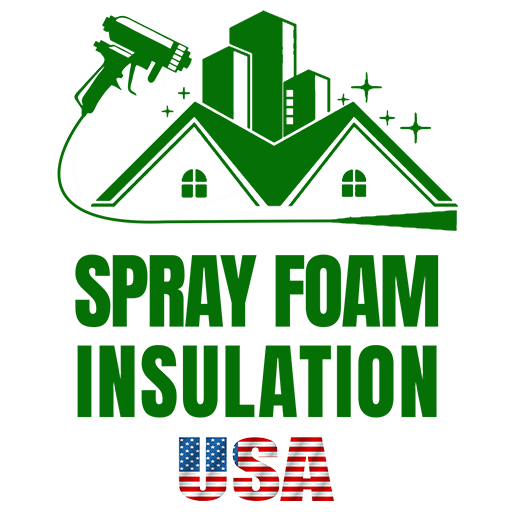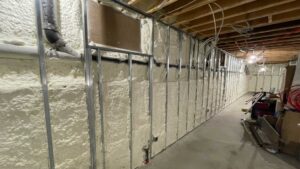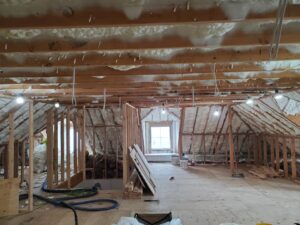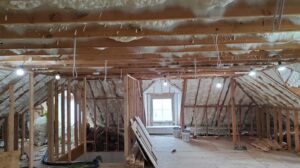Attic door insulation is a critical aspect of home energy efficiency. Proper insulation of this area can lead to significant cost savings, enhance energy efficiency, and contribute to a more comfortable indoor environment. Whether you’re in the chilly winters or harsh summers, insulating your attic door helps maintain your home’s temperature, reduces the workload on your HVAC system, and decreases your energy bills.
A key step for anyone looking to cut energy costs and reduce heat loss is ensuring your attic door is well-insulated. This introductory guide will walk you through why insulating your attic door is not just a good practice, but a necessary step towards more sustainable living.
- Reduce Energy Bills: Proper insulation keeps heated or cooled air where you want it – inside your home.
- Comfort All Year Round: Insulation minimizes temperature fluctuations by reducing the air leaks through attic doors.
- Protect Your Home: Consistent indoor temperatures prevent the structural stress caused by thermal expansion and contraction.

Understanding the basics of attic door insulation is the first step in transforming your home into a more energy-efficient and comfortable living space.
Understanding Attic Door Insulation
When it comes to attic door insulation, understanding the types of insulation, their benefits, and the common issues of energy loss is crucial. This knowledge will guide your choices in materials and methods, ensuring that your insulation project is successful and effective.
Types of Insulation
Attic doors can generally be insulated using three main types of materials:
- Fiberglass Insulation: This is commonly available and works by trapping pockets of air, thus slowing the spread of heat and cold.
- Rigid Foam Insulation: Known for its high R-values per inch, rigid foam cuts easily to fit snugly around any space, making it ideal for flat attic hatches.
- Reflective Foil Insulation: This type uses a metallic foil surface to reflect heat away from the attic space and is often used in conjunction with other insulation types for maximum effect.
Each type of insulation material offers distinct advantages and can be chosen based on the specific needs of your home and attic door type.
Benefits of Proper Attic Door Insulation
Insulating your attic door brings several key benefits:
- Energy Efficiency: Proper insulation reduces the need for heating and cooling, lowering energy costs.
- Comfort: A well-insulated attic door helps maintain a consistent temperature in your living spaces, enhancing overall comfort.
- Environmental Impact: By reducing energy consumption, you also decrease your home’s carbon footprint.
Understanding Energy Loss
Energy loss through attic doors occurs mainly due to:
- Air Leaks: Even small gaps around the attic door can lead to significant energy loss, as warm or cool air escapes, forcing your HVAC system to work harder.
- Thermal Bridging: If the attic door frame or the surrounding area lacks sufficient insulation, heat can pass through these materials, bypassing other insulated areas.
By addressing both air leaks and thermal bridging, you effectively minimize energy loss. This not only saves on utility bills but also extends the life of your heating and cooling systems by reducing their workload.
In conclusion, understanding the types of insulation available, the benefits of insulating your attic door, and the common pathways of energy loss are essential steps in ensuring your home remains energy efficient. By tackling these aspects, you set the stage for a more comfortable and cost-effective living environment. Moving forward, the next sections will guide you through preparing for and executing your attic door insulation project.
Preparing for Attic Door Insulation
Proper preparation is key to a successful attic door insulation project. Before you start, it’s important to gather the right tools, ensure safety, and accurately measure your attic door. This preparation not only makes the installation process smoother but also ensures that the insulation will be effective in enhancing your home’s energy efficiency.
Safety Measures
Safety should always be your top priority when working on home improvement projects, especially in areas like the attic where there can be hidden hazards.
- Wear safety glasses to protect your eyes from dust and debris.
- Use gloves to prevent skin irritation from insulation materials and to avoid splinters or cuts.
- A dust mask or respirator is crucial to avoid inhaling insulation particles or dust.
- Consider a hard hat if your attic has low clearance to protect your head from bumps.
Tools Needed
Having the right tools at hand is essential for a smooth installation process. Here’s what you’ll need:
- Measuring tape to measure the door and insulation material.
- Utility knife for cutting insulation to the exact size.
- Caulking gun for applying sealant.
- Staple gun if you are using fiberglass batt insulation.
- Screwdriver or drill for attaching insulation panels or adjusting parts of the attic door.
Measuring Your Attic Door
Accurate measurement is critical to ensure that the insulation fits perfectly and provides maximum energy efficiency.
- Measure the door: Start by measuring the height and width of your attic door. It’s a good idea to measure twice to ensure accuracy.
- Check the depth: Measure the depth of the door to determine the thickness of insulation material you can use without hindering the door’s operation.
- Note any irregularities: Look for any unique features or irregularities around the door frame that may require special attention during insulation.
By carefully preparing for your attic door insulation project, you ensure that you have all the necessary tools and safety gear, and that you’ve accurately measured the space. This preparation not only facilitates a smoother installation process but also ensures that your attic door insulation is set up for optimal performance, leading directly into the detailed steps of the installation process.
Step-by-Step Guide to Insulating Your Attic Door
Choosing the Right Insulation Material
Before diving into the installation process, it’s crucial to select the most suitable insulation material for your attic door. The three popular choices are:
- Fiberglass: This material is lightweight and traps air within its fibers, which helps to reduce heat transfer. It’s a cost-effective option for DIY projects.
- Rigid Foam: Available in types like EPS, XPS, and Polyiso, rigid foam offers higher R-values, meaning it’s more effective at preventing heat escape.
- Reflective Foil: Ideal for reflecting heat, this material is best used in combination with other forms of insulation to enhance energy efficiency.
Installing Fiberglass Insulation
To install fiberglass insulation on your attic door, follow these steps:
- Measure and Cut: First, measure your attic door to determine the amount of insulation needed. Cut the fiberglass batts slightly larger than the door to ensure complete coverage.
- Staple the Fiberglass: Position the cut batts over the door with the fiberglass side facing the attic. Secure the batts to the door using a staple gun, ensuring the material is evenly attached without gaps.
- Add Weatherstripping: Apply self-adhesive weatherstripping around the perimeter of the door frame. This step is crucial to prevent air leaks and enhance the overall effectiveness of the insulation.
Constructing a Rigid Foam Box
For those opting for rigid foam due to its higher insulating properties, constructing a box over the attic door can provide excellent sealing and insulation. Here’s how to do it:
- Measure: Go into the attic and measure the framed opening of the attic door. Include any additional components like fold-down stairs if present.
- Cut the Foam: Transfer the measurements to your rigid foam board. Use a sharp knife or saw to cut the pieces that will form the sides and top of the box.
- Assemble: Apply construction adhesive to the edges of the cut foam pieces and assemble them into a box shape. Ensure that the box fits snugly over the framed opening without forcing it into place.
- Seal: Use packing or duct tape to reinforce the corners and joints of the box. Additionally, apply a bead of caulk around the edges where the box meets the attic floor to eliminate any air leaks.
By following these detailed steps and choosing the right material, you can effectively insulate your attic door, leading to improved energy efficiency and reduced heating and cooling costs. The key to successful attic door insulation lies in meticulous installation and ensuring all potential air leaks are sealed.
Attic Door Insulation Alternatives
When considering alternatives to traditional DIY insulation methods for your attic door, there are several convenient and effective options available. These alternatives are especially useful if you’re looking for a quicker setup or if your attic door has unique dimensions or configurations that make custom solutions necessary.
Pre-made Covers
Pre-made attic door covers are a popular choice for many homeowners. These covers are typically constructed from insulating materials like high-density foam and are designed to fit snugly over your attic door. They are easy to install—often coming with a zipper or Velcro closures—and can be removed just as easily for access to the attic.
One of the main benefits of pre-made covers is their convenience. There is no need for measuring, cutting, or attaching materials to the attic door itself. Simply place the cover over the door, and you’re done. This makes it an ideal solution for those who may not be comfortable with more involved DIY projects.
Foil Tents
Foil tents work by reflecting heat, making them an excellent choice for homes in warmer climates where heat gain in the attic can significantly affect home cooling costs. These tents are usually made from radiant barrier materials that reflect a substantial portion of radiant heat away from the attic space.
Installing a foil tent is straightforward. The tent is usually suspended above the attic stairs or door, creating an air gap that enhances its insulating properties. This setup not only helps in temperature regulation but also in preventing dust and debris from entering the living spaces through the attic.
EPS Kits
Expanded Polystyrene (EPS) kits are another alternative that offers robust insulation with relatively easy installation. These kits often come in segments that fit together around your attic door, creating a tight seal that improves both thermal and air insulation.
EPS has a lower thermal conductivity compared to other materials, which means it does an excellent job at slowing down the transfer of heat. Kits typically include all necessary components and have detailed instructions to guide you through the installation process. This can be a great project for those who enjoy a bit of DIY but want the simplicity of a pre-cut, easy-to-assemble solution.
By exploring these attic door insulation alternatives, you can choose the option that best fits your needs and skills. Whether you opt for the simplicity of a pre-made cover, the reflective benefits of a foil tent, or the custom fit of an EPS kit, each provides a viable route to enhance your home’s energy efficiency and comfort. A well-insulated attic door is key to maintaining temperature control and reducing overall energy costs in your home.
Enhancing Insulation Efficiency
To further boost the effectiveness of your attic door insulation, it’s crucial to focus on air sealing, weather stripping, and caulking. These steps ensure that no air leaks around the attic door, maximizing your home’s energy efficiency and reducing heating and cooling costs.
Air Sealing
Air sealing is essential in preventing warm or cool air from escaping your home, which can lead to significant energy loss. For attic doors, use a combination of foam sealant for larger gaps and silicone caulk for smaller cracks. This process involves:
- Identifying Leaks: Before starting, inspect the attic door and surrounding area for any visible gaps or light penetration.
- Applying Foam Sealant: For gaps larger than 1/4 inch, use an expanding foam sealant. Ensure you wear protective gloves and follow the manufacturer’s instructions.
- Addressing Smaller Cracks: Silicone caulk is perfect for smaller cracks. It’s flexible, waterproof, and can handle temperature changes well.
Weather Stripping
Adding weather stripping around the attic door helps create a tight seal that prevents air from leaking. This is how you can apply weather stripping effectively:
- Choose the Right Type: Select a weather stripping material that can withstand compression and temperature changes, such as EPDM rubber.
- Clean the Surface: The door frame must be clean and dry to ensure the adhesive sticks properly.
- Measure and Cut: Measure the length of each side of the door frame and cut the weather stripping accordingly.
- Install: Attach the weather stripping around the perimeter of the door frame, ensuring there are no gaps or overlaps.
Caulking
Caulking is used to seal the attic door frame and any cracks around the casing, complementing the flexibility of weather stripping for moving parts like the door itself. Here’s how to apply caulk for optimal sealing:
- Selecting the Right Caulk: Use a silicone-based caulk for better durability and elasticity.
- Application: Run a bead of caulk along any gaps where air might escape, especially at the intersection of the door frame and the house framing.
- Smoothing: After application, smooth the caulk bead with a wet finger or a caulking tool to ensure a clean, finished appearance.
By implementing these strategies, your attic door will not only be well-insulated but also sealed against air leaks. This comprehensive approach helps maintain a consistent temperature in your home, easing the workload on your heating and cooling systems, and ultimately saving on energy costs.
Next, let’s dive into some of the most common questions homeowners have about attic door insulation to clear up any confusion and provide practical advice.
Frequently Asked Questions about Attic Door Insulation
What can I use to insulate an attic door?
To insulate an attic door effectively, you have several reliable options:
- Rigid Foam: Known for its high R-value and ease of installation, rigid foam is an excellent choice for creating an insulation barrier. It can be cut to fit the door precisely, offering a snug fit that reduces heat transfer.
- Fiberglass: This common insulation material can be attached directly to the door using staples. It’s important to ensure it’s not compressed too much to maintain its insulating properties.
- Reflective Foil: Especially useful in warmer climates, reflective foil can reflect heat away, helping to keep the attic space cooler.
Do attic door insulations work?
Absolutely! Properly installed attic door insulation can lead to significant energy savings by reducing the amount of heat lost during winter and keeping your home cooler during the hot months. This not only lowers energy bills but also enhances the overall comfort of your home.
How to weatherstrip an attic door?
Weatherstripping is crucial for preventing air leaks around your attic door. Here’s how to do it effectively:
- Choose the Right Type: Various types of weatherstripping are available, such as foam, rubber, and silicone. Each has its benefits, so select one that best fits the gap size and location.
- Clean the Area: Ensure the door frame is clean and dry before applying weatherstripping. This improves adhesion.
- Measure and Cut: Measure the length of the area where you will apply the weatherstrip. Cut your weatherstripping to fit these measurements.
- Install: Peel off the backing (if self-adhesive) and press the weatherstrip firmly into place around the perimeter of the door frame. For non-adhesive types, you may need to use staples or nails.
Implementing these steps will help seal off any drafts and improve the efficiency of your attic door insulation, making your home more energy-efficient and comfortable.
Conclusion
Long-term Benefits of Attic Door Insulation
Insulating your attic door is not just a one-time benefit; it’s an investment in the future of your home. Proper attic door insulation leads to significant energy savings by reducing the need for excessive heating in the winter and cooling in the summer. This consistent temperature regulation not only lowers energy bills but also extends the lifespan of your HVAC system due to reduced strain.
Moreover, enhancing your home’s insulation contributes to its overall value. Prospective homebuyers often look for homes that demonstrate a commitment to energy efficiency, which can make your property more attractive on the market.
Maintenance Tips for Attic Door Insulation
Maintaining your attic door insulation is straightforward but essential for ensuring its longevity and effectiveness:
– Regular Checks: Inspect the insulation annually for any signs of damage or displacement. Look for gaps or areas where the insulation may have compressed.
– Pest Control: Keep an eye out for pests that might burrow into or damage the insulation. Consider pest control solutions if necessary.
– Clean Surfaces: Ensure that the surfaces around the attic door are clean before installing insulation. This helps in preventing mold growth and maintains the quality of the air inside your home.
Choosing Spray Foam Insulation USA
At Spray Foam Insulation USA, we understand that choosing the right insulation solution is critical for not just comfort but also for achieving long-term energy savings. Our spray foam insulation offers superior R-values, making it an excellent choice for attic door insulation. With our professional guidance, the installation process is seamless, ensuring that every corner of your attic door is covered without any gaps.
Opting for Spray Foam Insulation USA means choosing a partner who values your comfort and energy efficiency as much as you do. We are dedicated to providing you with the best insulation solutions that not only save you money but also enhance the livability of your home.
Implementing attic door insulation is a smart move for any homeowner looking to improve their home’s energy efficiency and comfort. With the right approach and support from Spray Foam Insulation USA, you can enjoy a warmer, more efficient space that meets your needs year-round. Let’s work together to make your home the best it can be.





